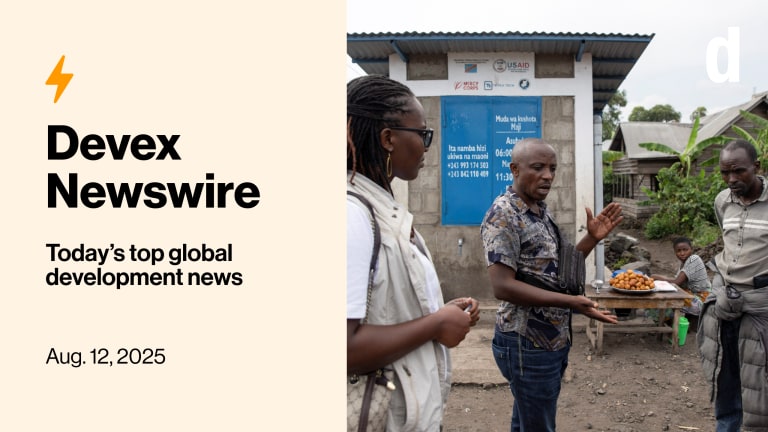Our reforms are succeeding, USAID says
USAID outlined its successes in a progress report unveiled today at an event co-hosted by the American Enterprise Institute and Center for American Progress.
In 2010, the U.S. Agency for International Development embarked on an ambitious reform agenda that aims to build local partnerships, foster innovation and strengthen the agency’s capacity to deliver results. USAID outlined its successes in a progress report unveiled today at an event co-hosted by the American Enterprise Institute and Center for American Progress. At the event, USAID Administrator Rajiv Shah made a case for continuing the agency’s reform project despite lingering concerns especially from budget hawks, conservative lawmakers and U.S. contractors afraid they may lose business if the agency amps up local partnerships abroad. The event was attended by top USAID brass and a wide swath of aid leaders in the realms of consulting, nonprofits, think tanks and academia – and indication perhaps of the uncertainty surrounding the future of U.S. aid in today’s highly partisan political environment and amid government-wide cuts as a result of the sequester. “After more more than two years, USAID Forward has touched upon every part of our agency, bringing new partnerships, a greater emphasis on innovation and a relentless focus on results,” Shah says in the report. “Taken together, these reforms have formed the foundation of a new model for development.” The reform is meant to revive an agency criticized for being too occupied to listen to the needs of country partners, weighed down by procurement delays and bogged down by implementation bottlenecks. The report highlights eight indicators that, according to USAID, provide for the first time real metrics to plot the agency’s progress across countries and time. But the report also admits the reform’s ultimate success is far from certain. “The large-scale transformation of a federal agency is a long-term and complex endeavor,” the report notes. “Transformation will be successful if it not only changes the way we do business, but also results in improved results and continued development progress.” In strengthening its capacity to deliver results, USAID plans to complete at least 70 country development strategies by 2014, churn out 250 high-quality evaluation reports and increase to 300 by 2014 the number of foreign service officers and mentors who participate in a mentoring program. So far, USAID has missed its target of publishing evaluation reports. Last year, it was able to publish 186 reports instead of the 250 it had originally planned. “Designing country strategies was more time and labor intensive than originally anticipated, particularly because a large number of partners were engaged in the process to determine tough trade-offs,” the report notes. Still, the agency has approved 20 country programs in 2012 and it plans to finish nearly all of its country strategies this year. Surpassing its target for 2012, USAID doubled the number of foreign service officers and foreign service nationals who were mentored. “A real challenge in the year ahead will be to move from anecdotal to evidence-based assessments of success, including clear definitions and measures of capacity development,” according to the report. Through the years, critics have argued that USAID’s model of development has excluded local partners from decision-making processes. As a result, the criticism goes, partners don’t have a sense of ownership for programs that are supposedly intended for them. USAID Forward is meant to change this by transforming the way USAID does business through more direct investment in local institutions, businesses, governments and NGOs. “In FY 2010, only 9.7 percent of mission funding was awarded directly to local institutions, which meant that we were not directly supporting the change-agents and problem-solvers who were charting their nation’s development,” the report notes. “Today, 14.3 percent of mission funds are awarded directly to local institutions, putting us half-way toward our five-year goal of 30 percent by 2015.” But forging stronger local partnerships remains a work in progress. Last year, USAID wanted about 70 percent of U.S. staff work plans to include at least one direct engagement performance measure. The agency achieved only 57 percent in 2012. This year, at least 10 percent of USAID’s public-private partnerships should involve cost-sharing of at least 1-to-1. Last year, that rate was 1 percent. The last pillar of USAID’s three-pronged reform agenda is to tap innovations in sciences and technology to address development challenges. As development issues become complex and access to poor communities remains tough in conflict-ridden states, technology can bridge the service delivery gap, the agency says. Mobile technologies have become the new means of providing assistance to victims of conflict, war and disasters whom development actors cannot physically attend to. This year, USAID wants at least 10 of its missions to support mobile money initiatives. So far, the agency is on track to achieving this goal. Last year, six missions used mobile technology to deliver services. “In the coming year, USAID will be working with our partners and missions to scale up new technologies that are making an impact,” the report notes. Read more on U.S. aid reform online, and subscribe to The Development Newswire to receive top international development headlines from the world’s leading donors, news sources and opinion leaders — emailed to you FREE every business day.
In 2010, the U.S. Agency for International Development embarked on an ambitious reform agenda that aims to build local partnerships, foster innovation and strengthen the agency’s capacity to deliver results.
USAID outlined its successes in a progress report unveiled today at an event co-hosted by the American Enterprise Institute and Center for American Progress.
At the event, USAID Administrator Rajiv Shah made a case for continuing the agency’s reform project despite lingering concerns especially from budget hawks, conservative lawmakers and U.S. contractors afraid they may lose business if the agency amps up local partnerships abroad. The event was attended by top USAID brass and a wide swath of aid leaders in the realms of consulting, nonprofits, think tanks and academia – and indication perhaps of the uncertainty surrounding the future of U.S. aid in today’s highly partisan political environment and amid government-wide cuts as a result of the sequester.
This story is forDevex Promembers
Unlock this story now with a 15-day free trial of Devex Pro.
With a Devex Pro subscription you'll get access to deeper analysis and exclusive insights from our reporters and analysts.
Start my free trialRequest a group subscription Printing articles to share with others is a breach of our terms and conditions and copyright policy. Please use the sharing options on the left side of the article. Devex Pro members may share up to 10 articles per month using the Pro share tool ( ).
As a former Devex staff writer, John Alliage Morales covered the Americas, focusing on the world's top donor hub, Washington, and its aid community. Prior to joining Devex, John worked for a variety of news outlets including GMA, the Philippine TV network, where he conducted interviews, analyzed data, and produced in-depth stories on development and other topics.








